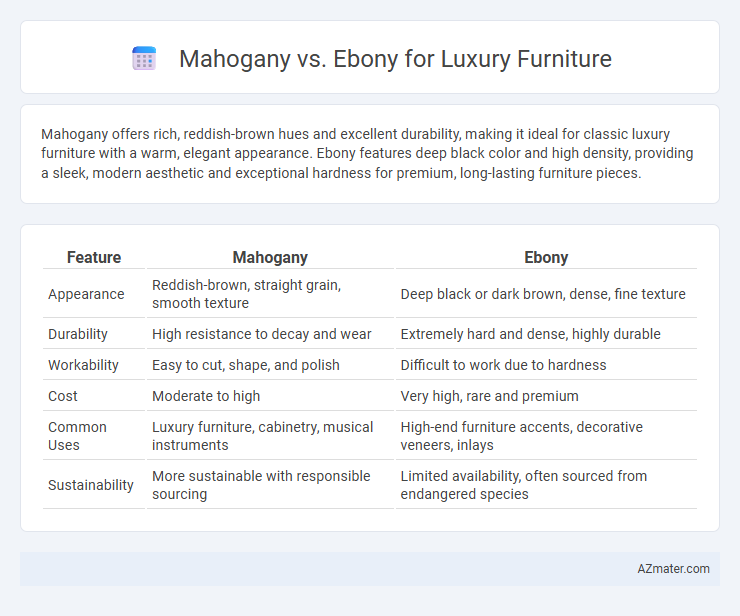Mahogany offers rich, reddish-brown hues and excellent durability, making it ideal for classic luxury furniture with a warm, elegant appearance. Ebony features deep black color and high density, providing a sleek, modern aesthetic and exceptional hardness for premium, long-lasting furniture pieces.
Table of Comparison
| Feature | Mahogany | Ebony |
|---|---|---|
| Appearance | Reddish-brown, straight grain, smooth texture | Deep black or dark brown, dense, fine texture |
| Durability | High resistance to decay and wear | Extremely hard and dense, highly durable |
| Workability | Easy to cut, shape, and polish | Difficult to work due to hardness |
| Cost | Moderate to high | Very high, rare and premium |
| Common Uses | Luxury furniture, cabinetry, musical instruments | High-end furniture accents, decorative veneers, inlays |
| Sustainability | More sustainable with responsible sourcing | Limited availability, often sourced from endangered species |
Introduction to Luxury Wood Choices: Mahogany and Ebony
Mahogany and ebony are two of the most sought-after woods in luxury furniture due to their unique aesthetic qualities and durability. Mahogany boasts a rich reddish-brown color with a fine, straight grain, prized for its warmth and classic elegance, while ebony features an intense black hue with a smooth, dense texture that conveys sophistication and exclusivity. Both hardwoods offer exceptional resistance to wear and are favored for crafting high-end furniture pieces that combine beauty with longevity.
Origins and Availability of Mahogany and Ebony
Mahogany originates primarily from Central and South America, especially countries like Honduras and Brazil, while ebony is native to tropical regions of Africa and Asia, notably Gabon and India. Mahogany is more widely available due to sustainable plantations and managed forests, whereas ebony is rarer and often harvested from endangered species, increasing its scarcity and price. The natural growth cycles and conservation challenges directly influence the market availability of both woods in luxury furniture production.
Visual Appeal: Color, Grain, and Texture Comparison
Mahogany features a warm reddish-brown hue with a straight, fine grain that creates a smooth, elegant surface ideal for luxury furniture. Ebony is renowned for its deep, jet-black color and dense, fine-grained texture, offering a striking, sophisticated contrast in high-end designs. The rich, warm tones of mahogany evoke classic luxury, while ebony's dark, glossy finish delivers a bold, modern aesthetic perfect for statement pieces.
Durability and Hardness: Which Wood Lasts Longer?
Mahogany offers excellent durability with a Janka hardness rating around 800-900, making it resistant to wear and dents in luxury furniture applications. Ebony, known for its exceptional hardness with a Janka rating often exceeding 3,000, provides superior longevity and resistance to damage. Despite Mahogany's durability and attractive grain, Ebony's extreme hardness ensures it lasts significantly longer, especially in high-use luxury furniture pieces.
Workability and Crafting Ease
Mahogany offers superior workability and crafting ease compared to ebony due to its softer texture and uniform grain, allowing artisans to achieve intricate details with less effort and tool wear. Ebony's density and hardness, while providing exceptional durability and a luxurious finish, challenge craftsmen with increased difficulty in cutting, shaping, and carving, often requiring specialized tools and expertise. For luxury furniture, mahogany ensures smoother construction processes and faster production times, whereas ebony demands meticulous skill and patience, impacting both craftsmanship and cost.
Maintenance and Aging: How Each Wood Matures
Mahogany develops a rich, deep patina over time, enhancing its warm reddish-brown hues with minimal maintenance due to its natural resistance to rot and insects. Ebony ages with a sleek, glossy black finish that requires more careful upkeep to prevent surface scratches and preserve its dense, smooth texture. Both woods darken and mature beautifully, but mahogany's forgiving nature and ease of aging make it ideal for long-lasting luxury furniture.
Environmental Impact and Sustainability
Mahogany and ebony are both prized hardwoods in luxury furniture, but their environmental impacts differ significantly due to their growth rates and harvesting practices. Mahogany, often sourced from tropical forests, faces threats from illegal logging and slow regeneration, leading to deforestation and habitat loss, whereas ebony trees grow even more slowly, making them highly susceptible to overexploitation and population decline. Sustainable furniture production emphasizes certified wood from responsibly managed forests, with mahogany certified by organizations like FSC offering a relatively better option compared to ebony, which remains critically endangered in many regions.
Price Comparison: Mahogany vs Ebony
Mahogany furniture typically costs less than ebony due to mahogany's wider availability and easier sourcing, making it a more budget-friendly option for luxury wooden pieces. Ebony, known for its dense, jet-black appearance and rarity, commands a significantly higher price, often two to three times that of mahogany per board foot. The premium pricing of ebony reflects its durability, unique aesthetic, and limited supply, positioning it as an exclusive choice in luxury furniture markets.
Best Applications in Luxury Furniture Design
Mahogany excels in luxury furniture design due to its rich, reddish-brown hue and fine grain, making it ideal for intricate carvings and classic, elegant pieces like dining tables and cabinets. Ebony, characterized by its deep black color and dense hardness, is best suited for high-end accents, inlays, and statement pieces such as piano keys, decorative veneers, and modern minimalist furniture. Both woods offer exceptional durability and timeless appeal, with mahogany favored for warmth and tradition, while ebony provides striking contrast and contemporary sophistication.
Making the Right Choice for Your Luxury Furniture
Mahogany offers a warm, reddish-brown hue with a fine, straight grain that enhances the elegance and durability of luxury furniture, making it ideal for classic designs. Ebony stands out with its deep black color and dense, smooth texture, providing a striking contrast and a symbol of opulence for high-end pieces. Choosing between mahogany and ebony depends on desired aesthetics, budget considerations, and furniture use, as mahogany tends to be more affordable and versatile, while ebony delivers a bold, prestigious statement.

Infographic: Mahogany vs Ebony for Luxury Furniture
 azmater.com
azmater.com